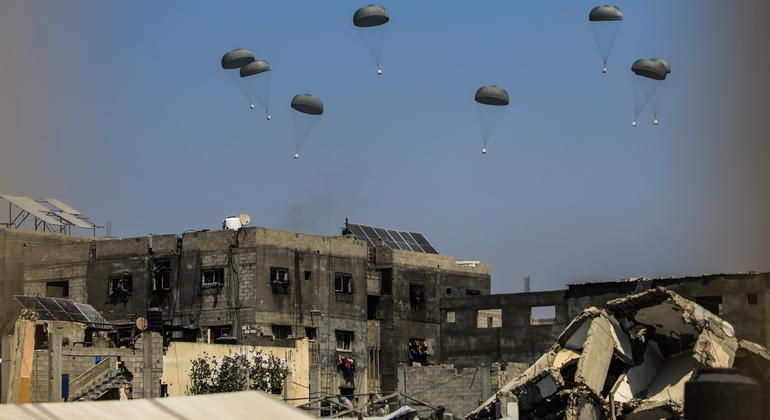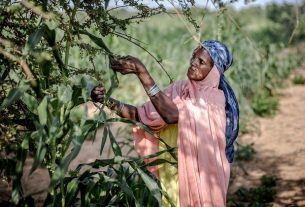These young deaths are “the latest in the war on children and childhood in Gaza,” Philippe Lazzarini, head of UN Palestine refugee agency UNRWA, said in a tweet on Wednesday.
The toll also includes some 40,000 boys and girls reported killed or injured due to bombardment and airstrikes, at least 17,000 unaccompanied and separated children, and one million deeply traumatised youngsters who are not getting an education.
“Children are children,” he said.
“No one should stay silent when children die, or are brutally deprived of a future, wherever these children are, including in Gaza.”
A sombre reunion
Thousands of sick children in Gaza need urgent medical evacuation, according to UN aid coordination office OCHA.
Olga Cherevko, a spokesperson for the agency, recalled the moment she recognized a young girl requiring treatment in a Gaza hospital after a year’s interval, once again suffering from malnourishment.
“I remembered her long eyelashes,” the veteran humanitarian told UN News, describing seven-year-old Janah, who she came across at Gaza City’s Patient Friendly Hospital on Tuesday.
“The first time I met her was in the IMC Field Hospital in southern Gaza in April 2024. Back then, she was severely malnourished and was getting treatment. And she gradually became better and was released eventually and went home.”
Seven-year-old Janah is treated at Gaza City’s Patient Friendly Hospital.
Evacuation saves lives
However, Janah was now back in hospital “because the malnutrition became aggravated and the condition that she has also is not properly diagnosed and cannot be properly diagnosed.”
The girl is on a list of people to be medically evacuated for treatment outside Gaza. The most recent evacuations took place last week when the World Health Organization (WHO) supported the transfer of 15 critically ill children to Jordan, but more than 14,800 people are still waiting.
Ms. Cherevko stressed the importance of ensuring that evacuations continue to save as many lives as possible.
More aid needed
She also pointed out that for children and adults with pre-existing conditions, their situation becomes worse with malnutrition.
“It wouldn’t be this way if they had proper nutrition, because these conditions existed before the starvation crisis and they weren’t getting as sick as they are now,” she said.
“This is why it’s imperative to make sure that we have proper conditions on the ground for adequate volumes of supplies to be entering – everything from food to medicine to nutrition to shelter,” she continued.
“And these lifelines have to be really enabled for us to be able to deliver this aid to the people in need.”
Dying from hunger
Her appeal comes as the Gaza health authorities reported on Wednesday that eight people, including three children, died due to malnutrition and starvation over the past 24 hours.
“Such reports have become a daily occurrence, reflecting the deepening humanitarian crisis and the urgent need for sustained assistance,” UN Spokesperson Stéphane Dujarric told journalists in New York.
He said WHO also conducted a refresher training at the Rantissi Children’s Hospital in Gaza City on Wednesday, focusing on the inpatient management of malnutrition.
Rantissi is one of the five nutrition stabilization centres in the enclave and the course aimed to help staff members stay current with new information.
“The recent surge in malnutrition cases among children has necessitated the establishment and scaling-up of these centres,” he explained.
Since January, more than 340 children have been admitted for malnutrition treatment. As of 5 August, 49 validated child deaths from malnutrition have been reported, with 39 among children under the age of five.
“There may very well be others who have died from the same causes that were not recorded” either by the Organization or by local health authorities, Mr. Dujarric said in response to a reporter’s question.
Trauma and mental health issues
In other developments, data collected by the UN and partners from over 900 households across Gaza in July indicated continuous trauma leading to mental health issues, including anxiety and depression.
Care staff also are traumatised, and partners working in the protection sector have started providing mental health and psychosocial support for their personnel.
Meanwhile, UN efforts to bring aid into the Gaza Strip continue.
Teams collected food and fuel from the Kerem Shalom and Zikim border crossings on Tuesday and other missions are still ongoing.
Goods enter but cash is low
Mr. Dujarric said the entry of goods has improved the market situation in terms of both prices and availability.
For example, a bag of sugar now averages 40 shekels, roughly $12, per bag, after peaking at about 600 shekels, equivalent to about $175.
“However, severe cash shortages are preventing families from being able to buy food, being able to buy water and being able to buy medicine,” he said.
Humanitarians have repeatedly stressed that the amount of aid and goods that can be brought into Gaza does not meet the minimum requirements of the population.
They continue to call for a ceasefire and for aid flows to be scaled up.



